You are using an out of date browser. It may not display this or other websites correctly.
You should upgrade or use an alternative browser.
You should upgrade or use an alternative browser.
Yet another 3rd Gen Montero "Build", also story time!
- Thread starter eyehate
- Start date
eyehate
Member
Ok, did some more troubleshooting and went to the junkyard.
First off, thank you so much for that outstanding post haolepinoy. When I cleaned it, I used carb cleaner and a brush, so hopefully I didn't mess the sensor up. That stuff evaporates rather quick.
The vacuum it is pulling after being fully warmed up and running well is solid at around 25.
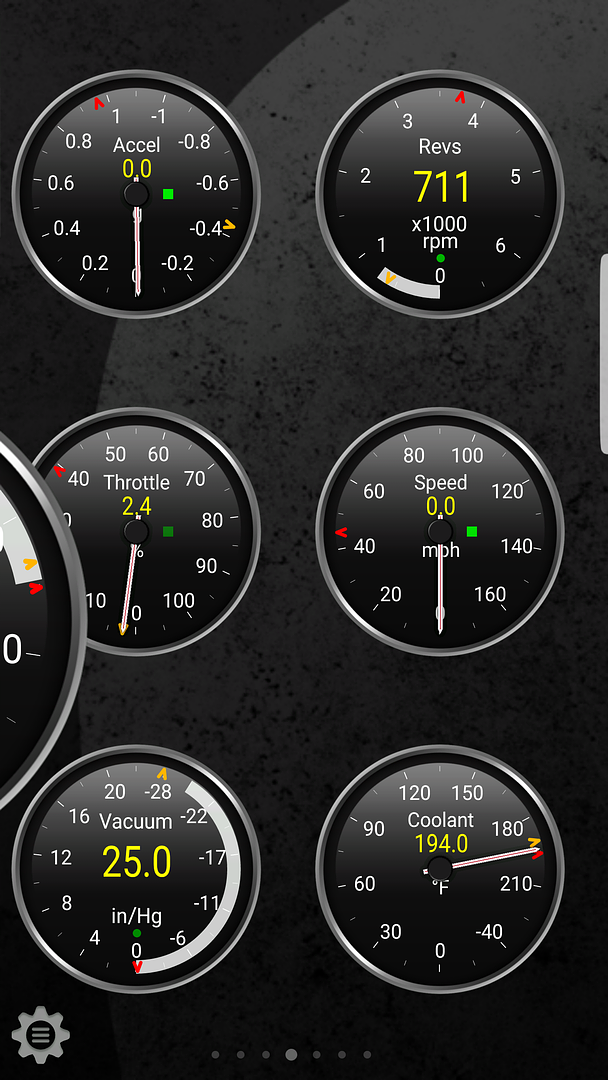
I only had some carb cleaner (no starting fluid) and sprayed around as many vacuum lines as I could see, with no audible changes to idle. I also cleaned out the ports in the intake manifold itself as they were pretty gummed up.
On to the junkyard to hope for a sensor.
No 03 Monteros there, and the 3 01s they had have a different EGR. So I whipped out google and saw that 2004 and up Endeavors, Eclipses and Galants all had the option of the 3.8. I rolled up to a 2006 Galant and took the EGR off of it. It looks a bit different and seems to have much much better heat sinks on it, and only needed to be unscrewed and flipped around so the sensor port was facing the right direction. Did that and tossed it on with a new gasket. EGR from U pull, 11.05, SCORE. The EGR makes noise now where the other one didn't at all during key on.
Still stumbles, much much less while in park, but putting it in R or D it stumbles badly the same way until warmed up. Quick video where you can see just idling back and forth in my driveway it stutters pretty badly almost like hitting the brakes over and over. You can hear it stumbling as well if you have audio on.
What is the next sensor down the line as I have replaced the MDP, and EGR now?
First off, thank you so much for that outstanding post haolepinoy. When I cleaned it, I used carb cleaner and a brush, so hopefully I didn't mess the sensor up. That stuff evaporates rather quick.
The vacuum it is pulling after being fully warmed up and running well is solid at around 25.

I only had some carb cleaner (no starting fluid) and sprayed around as many vacuum lines as I could see, with no audible changes to idle. I also cleaned out the ports in the intake manifold itself as they were pretty gummed up.
On to the junkyard to hope for a sensor.
No 03 Monteros there, and the 3 01s they had have a different EGR. So I whipped out google and saw that 2004 and up Endeavors, Eclipses and Galants all had the option of the 3.8. I rolled up to a 2006 Galant and took the EGR off of it. It looks a bit different and seems to have much much better heat sinks on it, and only needed to be unscrewed and flipped around so the sensor port was facing the right direction. Did that and tossed it on with a new gasket. EGR from U pull, 11.05, SCORE. The EGR makes noise now where the other one didn't at all during key on.
Still stumbles, much much less while in park, but putting it in R or D it stumbles badly the same way until warmed up. Quick video where you can see just idling back and forth in my driveway it stutters pretty badly almost like hitting the brakes over and over. You can hear it stumbling as well if you have audio on.
What is the next sensor down the line as I have replaced the MDP, and EGR now?
haolepinoy
Incomplete Idiot
Excuse the long post (I've been on an idle-related issue for a very long time now and have tried to learn how modern cars in general and my Monty in particular works along the way...full disclosure I am NO expert, just a shade-tree guy like you and most everybody else here).
Here's a list of interrelated components involved in idle issues: 1) the Mass Air Flow Sensor (aka VAF Sensor...which also includes the 2) Barometric Pressure Sensor and 3) Intake Air Temperature Sensor), 4) the Manifold Differential Pressure Sensor (aka MAP Sensor), 5) the Exhaust Gas Recirculation Valve, 6) the Evaporative Purge Solenoid Valve, 7) 8) 9) and 10) the upstream and downstream Heated Oxygen Sensors on bank 1 and 2, 11) the vacuum lines (there are a lot...under, around, behind the engine), 12) the intake manifold gaskets (again...there's a lot of gaskets between the Throttle Body and the Valvetrain), 13) the Positive Crankcase Ventilation Valve, 14) the Intake Manifold Tuning Solenoid, 15) thru 20) the individual Fuel Injectors, 21) the Fuel Pressure Regulator, 22) the Fuel Pump, 23) the Fuel Filter, 24) 25) the Upstream Catalytic Converters being clogged or inefficient, 26) 27) the Exhaust Manifolds (they commonly crack...resulting in a lean condition reading at the O2 sensors despite being after combustion), 28) the Electronic Throttle Control Actuator (aka our 3.8L's throttle body which also includes internally the 29) Throttle Control Actuator Motor, 30) the Electronic Throttle Position Sensor, 31) and buried deep in the PCM's logic, the Idle Air Control), 32) the Engine Coolant Sensor ... ... ... and honestly, unfortunately there is more.
My point: unless you have really deep pockets you're prepared to open, you can't just throw parts at "the next sensor down the line".
The 3.8L Montero, more so than all the others Monties (even the 3.5L Gen3s), is a highly logic-dependent vehicle. The PCM controls everything, and to do so requires the input of countless sensors before sending out commands to the myriad components that make the thing go. In order to truly diagnose any issues you must be able to put yourself inside this "internal conversation" and accurately understand what the vehicle is saying.
For example, your scan app shows a vacuum reading of 25 in/Hg (timeout...I'm not sure that the Gen3 actually has any sensors that measure actual vacuum, so I'm not totally sure what or where this PID comes from. The MDP sensor is PID #95 and is the measurement of the actual pressure inside the intake manifold, not necessarily vacuum in the negative sense...sorry if this is confusing, it is for me too). Let's assume that the 25 in/Hg is that #95 PID reading from your Gen3's computer (PCM). That would mean that your MDP sensor is reading 84.7 kPa (converted from in/Hg) inside your intake manifold at idle. It's only supposed to be 20.6 - 34.0 kPa. That number indicates a significant vacuum loss, aka leak. Now we have to find out what's causing that leak: vacuum hoses, pcv system leaks, egr system leaks, intake mani gasket leaks...but at least we know where to look. Your short term fuel trims should be showing a lean condition, which then tells your PCM to tell your fuel injectors to feed more gas to the engine to keep the magic 14.7:1 ratio (a conversation...sensor inputs > computer commands > engine actions).
The most important thing to learn first would be fuel trims and how that conversation happens. Very often when I've asked for help regarding my idle issues the first question experienced guys have asked is, "What's the fuel trim #s look like?" The reason for this is because it's the best bird's eye picture of what is happening in your engine's combustion cycle. I've benefitted from Schrodingers Box, and an hour or so spent on his channel learning how fuel trims work will probably be the best hour you've spent all week. As a bonus he has several videos in this playlist regarding how specific components like the EGR, MAF, and MAP contributes to the conversation.
https://www.youtube.com/playlist?list=PLKQS2gNIDMggela-mTBPpzT9P2TeKCgXb
Regarding the JY EGR...I honestly don't know. It could be good, or bad, or clapped out to somewhere in between...or simply not compatible despite having the same connector...or perfectly fine. But it is now a radical in things.
TL;DR summary: you need more data (especially fuel trim #s) before replacing anything else. Look harder for vacuum leaks (get a scan tool and monitor short term fuel trims while putting propane around the intake manifold...vacuum leaks that suck in propane will show as a rich condition (-%) even if you don't notice or hear a change in rpm).
Instead of sensors your next purchase/acquisition needs to be the Factory Service Manual (find Michael Brown on here...he's got links), a scan tool that reads live data (especially short and long term fuel trims), and a decent multimeter that reads voltage and resistance. I'd rather you spend good money and time on these than replacing expensive sensors and components.
Here's a list of interrelated components involved in idle issues: 1) the Mass Air Flow Sensor (aka VAF Sensor...which also includes the 2) Barometric Pressure Sensor and 3) Intake Air Temperature Sensor), 4) the Manifold Differential Pressure Sensor (aka MAP Sensor), 5) the Exhaust Gas Recirculation Valve, 6) the Evaporative Purge Solenoid Valve, 7) 8) 9) and 10) the upstream and downstream Heated Oxygen Sensors on bank 1 and 2, 11) the vacuum lines (there are a lot...under, around, behind the engine), 12) the intake manifold gaskets (again...there's a lot of gaskets between the Throttle Body and the Valvetrain), 13) the Positive Crankcase Ventilation Valve, 14) the Intake Manifold Tuning Solenoid, 15) thru 20) the individual Fuel Injectors, 21) the Fuel Pressure Regulator, 22) the Fuel Pump, 23) the Fuel Filter, 24) 25) the Upstream Catalytic Converters being clogged or inefficient, 26) 27) the Exhaust Manifolds (they commonly crack...resulting in a lean condition reading at the O2 sensors despite being after combustion), 28) the Electronic Throttle Control Actuator (aka our 3.8L's throttle body which also includes internally the 29) Throttle Control Actuator Motor, 30) the Electronic Throttle Position Sensor, 31) and buried deep in the PCM's logic, the Idle Air Control), 32) the Engine Coolant Sensor ... ... ... and honestly, unfortunately there is more.
My point: unless you have really deep pockets you're prepared to open, you can't just throw parts at "the next sensor down the line".
The 3.8L Montero, more so than all the others Monties (even the 3.5L Gen3s), is a highly logic-dependent vehicle. The PCM controls everything, and to do so requires the input of countless sensors before sending out commands to the myriad components that make the thing go. In order to truly diagnose any issues you must be able to put yourself inside this "internal conversation" and accurately understand what the vehicle is saying.
For example, your scan app shows a vacuum reading of 25 in/Hg (timeout...I'm not sure that the Gen3 actually has any sensors that measure actual vacuum, so I'm not totally sure what or where this PID comes from. The MDP sensor is PID #95 and is the measurement of the actual pressure inside the intake manifold, not necessarily vacuum in the negative sense...sorry if this is confusing, it is for me too). Let's assume that the 25 in/Hg is that #95 PID reading from your Gen3's computer (PCM). That would mean that your MDP sensor is reading 84.7 kPa (converted from in/Hg) inside your intake manifold at idle. It's only supposed to be 20.6 - 34.0 kPa. That number indicates a significant vacuum loss, aka leak. Now we have to find out what's causing that leak: vacuum hoses, pcv system leaks, egr system leaks, intake mani gasket leaks...but at least we know where to look. Your short term fuel trims should be showing a lean condition, which then tells your PCM to tell your fuel injectors to feed more gas to the engine to keep the magic 14.7:1 ratio (a conversation...sensor inputs > computer commands > engine actions).
The most important thing to learn first would be fuel trims and how that conversation happens. Very often when I've asked for help regarding my idle issues the first question experienced guys have asked is, "What's the fuel trim #s look like?" The reason for this is because it's the best bird's eye picture of what is happening in your engine's combustion cycle. I've benefitted from Schrodingers Box, and an hour or so spent on his channel learning how fuel trims work will probably be the best hour you've spent all week. As a bonus he has several videos in this playlist regarding how specific components like the EGR, MAF, and MAP contributes to the conversation.
https://www.youtube.com/playlist?list=PLKQS2gNIDMggela-mTBPpzT9P2TeKCgXb
Regarding the JY EGR...I honestly don't know. It could be good, or bad, or clapped out to somewhere in between...or simply not compatible despite having the same connector...or perfectly fine. But it is now a radical in things.
TL;DR summary: you need more data (especially fuel trim #s) before replacing anything else. Look harder for vacuum leaks (get a scan tool and monitor short term fuel trims while putting propane around the intake manifold...vacuum leaks that suck in propane will show as a rich condition (-%) even if you don't notice or hear a change in rpm).
Instead of sensors your next purchase/acquisition needs to be the Factory Service Manual (find Michael Brown on here...he's got links), a scan tool that reads live data (especially short and long term fuel trims), and a decent multimeter that reads voltage and resistance. I'd rather you spend good money and time on these than replacing expensive sensors and components.
haolepinoy
Incomplete Idiot
Sorry if you already knew everything I said in that last post, haha. I am an idiot and assume most everybody else is too. You probably know more about cars and have way more access to tools than me (just watched some of your videos). Consider that last post me just talking to myself. Everything except for the "You need more data" thing.
eyehate
Member
No offense taken at all. I am a bolt on part, suspension, alignment type of guy. The electronics are daunting and is why we have minimal amounts on the drift car. Hope you enjoyed the videos!
That being said, tourque monitors fuel trims. But I'm not sure what I am looking for. Here a a couple screen shots a few seconds apart. I am watching his videos now on this stuff, so maybe some of it will help.
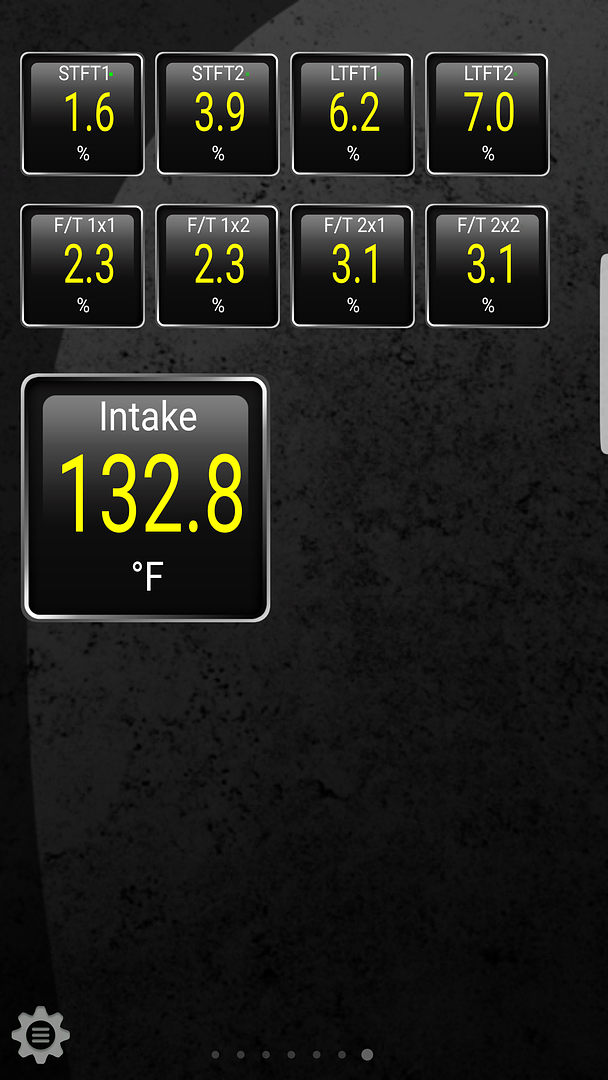
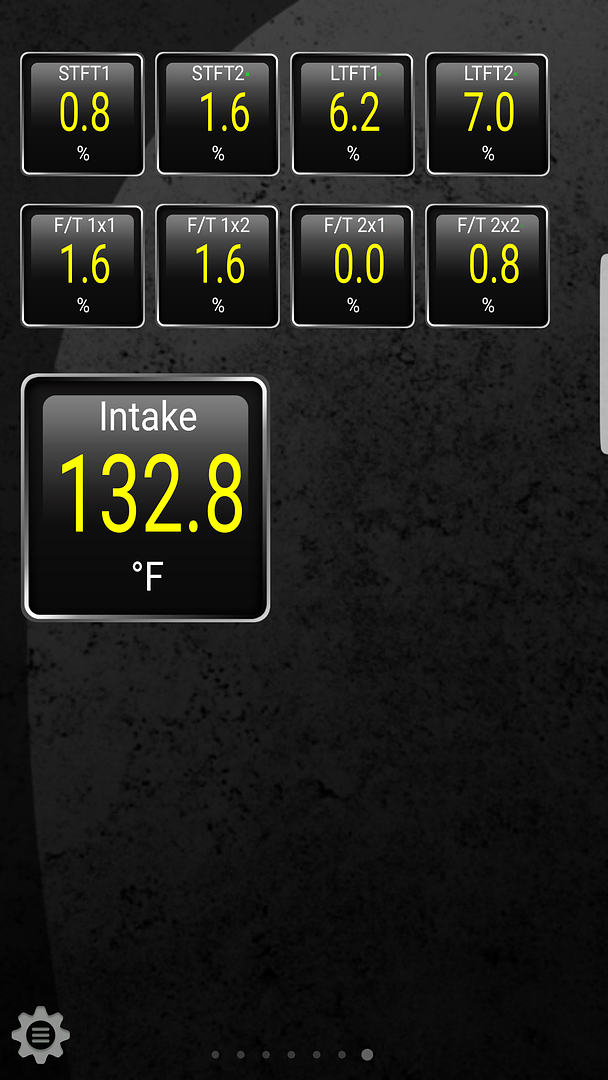
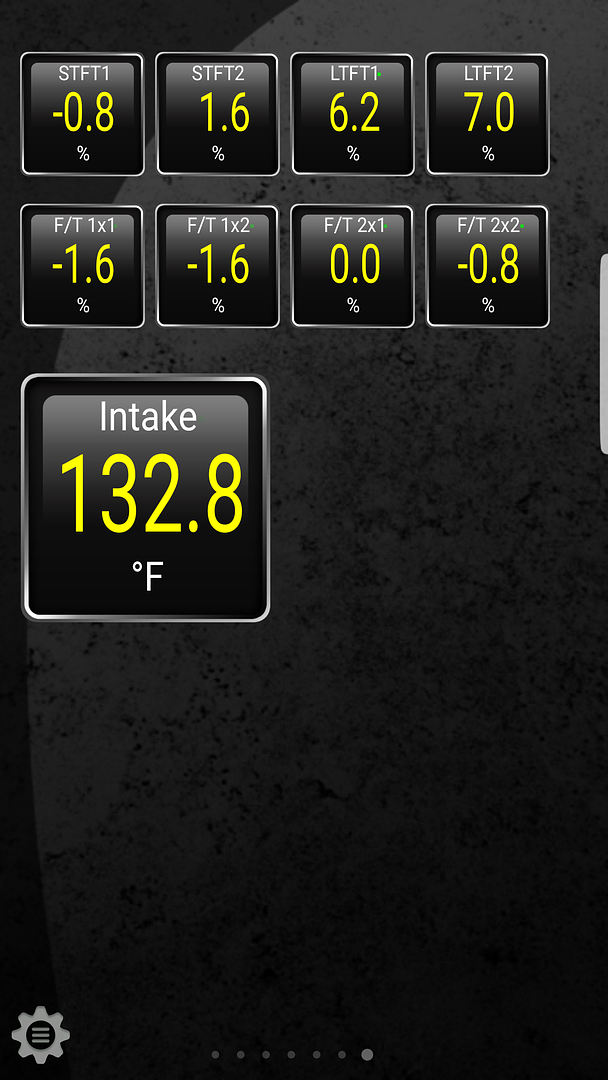
That being said, tourque monitors fuel trims. But I'm not sure what I am looking for. Here a a couple screen shots a few seconds apart. I am watching his videos now on this stuff, so maybe some of it will help.



Last edited:
eyehate
Member
Ok, watched both of his fuel trim videos so far, and you were right, great info on troubleshooting using long term and short term trims.
From what I understand, at idle my fuel trims are within spec, and I changed the pics above to graphs, which made things a lot easier. Long term at idle is 7, in his video he said under 10 is acceptable, and close to 5 don't bother. Short term at idle is really close to 0 or just above or below which he also said is in spec. Shown below:
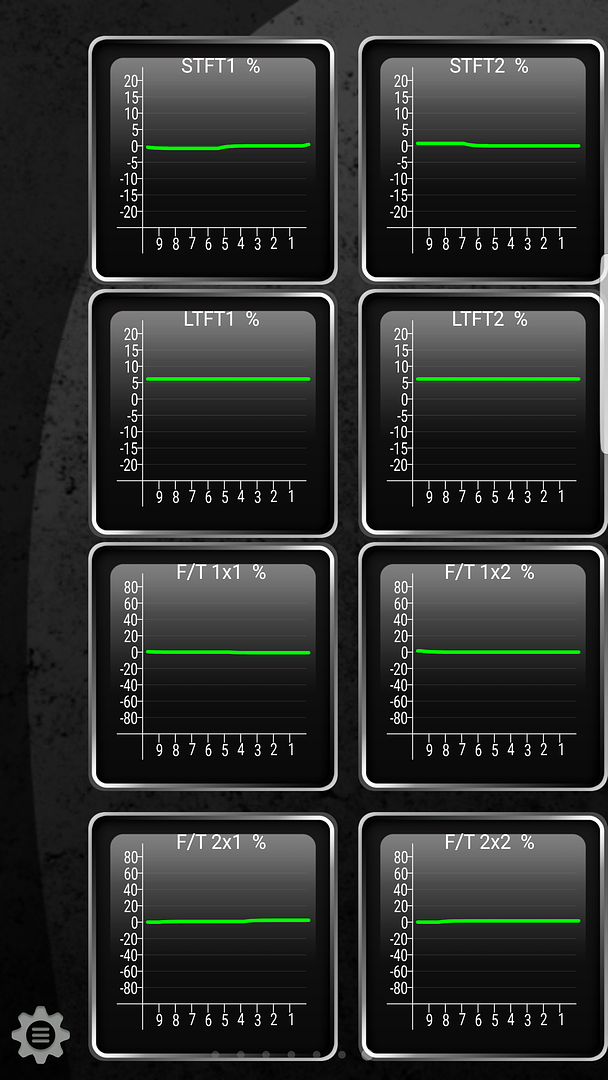
The big difference is when I hold at say 3800 RPM I get these changes:
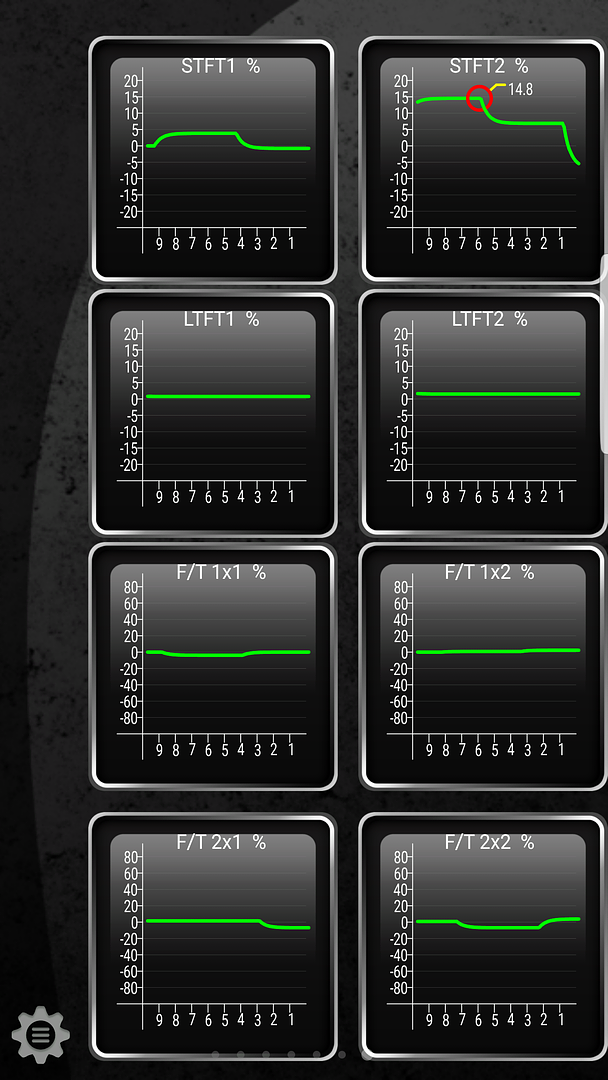
I also bought some starter fluid and while watching the trims live, sprayed almost a whole can top bottom and sides of the motor twice. It never went above 5 the entire time.
I still need to watch the rest of the videos but at least I know its not fuel pump or vacuum leak related!
From what I understand, at idle my fuel trims are within spec, and I changed the pics above to graphs, which made things a lot easier. Long term at idle is 7, in his video he said under 10 is acceptable, and close to 5 don't bother. Short term at idle is really close to 0 or just above or below which he also said is in spec. Shown below:

The big difference is when I hold at say 3800 RPM I get these changes:

I also bought some starter fluid and while watching the trims live, sprayed almost a whole can top bottom and sides of the motor twice. It never went above 5 the entire time.
I still need to watch the rest of the videos but at least I know its not fuel pump or vacuum leak related!
eyehate
Member
I seemed to have solved this...
I took everything off again. MDP sensor, throttle body, EGR, MAFS, intake. Cleaned it all again last night from top to bottom making sure there was absolutely no build up anywhere. I also changed the air filter itself (wasn't too dirty but you never know).
I noticed one of the tabs holding the upper intake box to the lower was broken, so I rigged a set of vice grips to hold it for the time being. I let it sit over night, and boom this morning when I started it, no shakes, no stumbles nothing but smooth idle. PUMPED.
I took everything off again. MDP sensor, throttle body, EGR, MAFS, intake. Cleaned it all again last night from top to bottom making sure there was absolutely no build up anywhere. I also changed the air filter itself (wasn't too dirty but you never know).
I noticed one of the tabs holding the upper intake box to the lower was broken, so I rigged a set of vice grips to hold it for the time being. I let it sit over night, and boom this morning when I started it, no shakes, no stumbles nothing but smooth idle. PUMPED.
haolepinoy
Incomplete Idiot
That's great man. Glad to hear it.
I think the tabs breaking on the Air Filter box is a common thing. Both of mine are broken, and all the air boxes in the junkyard that I have seen are broken too. Matter of fact, almost everything plastic under my hood is broken. Must have been a bad year for the Japanese plastic industry.
I think the tabs breaking on the Air Filter box is a common thing. Both of mine are broken, and all the air boxes in the junkyard that I have seen are broken too. Matter of fact, almost everything plastic under my hood is broken. Must have been a bad year for the Japanese plastic industry.
EyeInTheSky
Adventurer
Same with mine. Pretty much everything plastic is broken. I even had to drill a hole in the battery tray for one the battery hold downs to hook into. I did order replacement spark plug cable holders for a few bucks through the dealer though, since I'd prefer those don't melt.That's great man. Glad to hear it.
I think the tabs breaking on the Air Filter box is a common thing. Both of mine are broken, and all the air boxes in the junkyard that I have seen are broken too. Matter of fact, almost everything plastic under my hood is broken. Must have been a bad year for the Japanese plastic industry.
Any ideas on semi-permanent fixes (other than duct tape) for the air box?
Same with mine. Pretty much everything plastic is broken. I even had to drill a hole in the battery tray for one the battery hold downs to hook into. I did order replacement spark plug cable holders for a few bucks through the dealer though, since I'd prefer those don't melt.
Any ideas on semi-permanent fixes (other than duct tape) for the air box?
I was able to secure my airbox lid by drilling the tabs for sheetrock screws but I only have a couple thousand miles on that "repair". I drilled the top just enough for the screws to spin and the bottom small enough for a good bite.
coffeegoat
Adventurer
Here's a question - the airbox leaks are all upstream from the sensors - why would a leak cause problems?
Certainly you're bypassing the filter, which is bad, and perhaps the flow isn't as laminar as it could be, but it seems unlikely that you'd see that much of an issue. It would make total sense to me if it was downstream of the air sensors because the engine would be mis-reading the airflow and potentially run lean, but upstream it seems like it shouldn't have an effect...
My tabs are broken too, but I haven't seen any problems from it (so far), I'm curious if it's something I should be worrying about.
Certainly you're bypassing the filter, which is bad, and perhaps the flow isn't as laminar as it could be, but it seems unlikely that you'd see that much of an issue. It would make total sense to me if it was downstream of the air sensors because the engine would be mis-reading the airflow and potentially run lean, but upstream it seems like it shouldn't have an effect...
My tabs are broken too, but I haven't seen any problems from it (so far), I'm curious if it's something I should be worrying about.
haolepinoy
Incomplete Idiot
Here's a question - the airbox leaks are all upstream from the sensors - why would a leak cause problems?
The airbox obviously wasn't (isn't) the issue. Assuming the intake manifold/sensors r&r addressed the actual problem. Filtered air is a bonus, though.
eyehate
Member
Long time no update, been slowly but surely fixing all the "issues" this thing came with. I replaced the Gauge cluster with one from ebay, and swapped the odometer section with my old one to keep my mileage the same. I like the new white faces from the 04 cluster, and now all of my dummy lights, signals, etc work.

Also broke down and did the timing belt, water pump and pulleys, since I had no idea if the other owners had done it. While in there I also changed out the crank sensor and cam sensor, and those two things took away the CEL / traction control lights away.
Did my valve cover gaskets / spark plugs and wires. While doing that, I also removed the piston eating butterfly valves and made this video for it.
One of the head plugs on the back of the pass. side head was leaking like a siv, took that out cleaned it up and put fresh gasket on, no more leak!
I have added crossbars that I found on ebay for less than 100 bucks, just went snowboarding with my yakima racks attached and they seemed to work just great. Make sure to get length "A" as the others are not wide enough. Ebay link
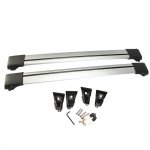

Also broke down and did the timing belt, water pump and pulleys, since I had no idea if the other owners had done it. While in there I also changed out the crank sensor and cam sensor, and those two things took away the CEL / traction control lights away.
Did my valve cover gaskets / spark plugs and wires. While doing that, I also removed the piston eating butterfly valves and made this video for it.
One of the head plugs on the back of the pass. side head was leaking like a siv, took that out cleaned it up and put fresh gasket on, no more leak!
I have added crossbars that I found on ebay for less than 100 bucks, just went snowboarding with my yakima racks attached and they seemed to work just great. Make sure to get length "A" as the others are not wide enough. Ebay link

